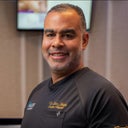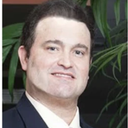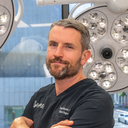My practice has been focused on awake Liposuction and fat transfer for the last decade.This discomfort or amount of pain varies substantially based on the skill or experience of the surgeon and how sensitive each individual patient is.It also varies on anatomic area and in need for aggressive Liposuction.Most of the procedure is not particularly painful but during the numbing aspect patients may feel jammed if the cannula touches the back of the skin or muscle fascia.In my experience the most painful aspect is the Liposuction itself of the lower abdomen around the belly button when it requires aggressive work.typically towards the end of Liposuction just before being finished.Patients can described it as a hot or burning sensation.For some people this is mildly uncomfortable at worst and others it becomes full-out painful(in my experience this does not happen often and can usually be managed with a second dose of pain medication, using more local anesthesia or temporarily breathing nitrous oxide(like dentists often do).I would say describing it to getting a tattoo is fair.For most patients as long as the surgeon is willing to stop and re-inject numbing medicine and balance sedation correctly it’s doable and the great majority of my patients find it preferable.There’s a very real learning curve to doing this procedure comfortably and getting patients through with appropriate results.Based on what you described you may indeed not be a great candidate for awake Liposuction.I’ve been doing this for a decade so I’m pretty good at reading people and helping people get through it.If your provider has only done a handful of awake Liposuction procedures it’s going to be far more challenging.It’s imperative that the surgeon is willing to take their time and not rush through the procedure.It often takes me three times longer to do awake Liposuction.Six hours is not uncommon for full body or if fat transfer is involved.Personally I assess each individual patient during in person consultations where I make an assessment of the patient’s previous response to medical/dental procedures. It’s not that difficult to assess someone’s pain tolerance.This procedure also has a propensity to get patient nauseous.typically it’s the combination of high doses of lidocaine and narcotic pain medication.Getting a thorough history of nausea and vomiting experiences helps me get through my procedures and decide who is an appropriate candidate.Habituation to narcotic pain medications is not that difficult to manage if the provider is willing to increase the dose. It does increase the risk of postoperative nausea and vomiting. When performing awake procedures surgeons have to stay within mild sedation which is often described as anxiety and pain control rather than sedation.Unless the procedure is scheduled in the facility with staff to handle moderate or deep sedation that level of sedation cannot and should never be attempted if scheduled for mild sedation or pain control.I converted to doing Liposuction as awake procedures about mid career.I had experienced plastic surgeons who were friends and mentors and showed me the way to get patients through comfortably.Unless a surgeon properly knows how to do for Liposuction cases using local anesthesia it can be an uncomfortable and undesirable situation.Once mastered it is a preferable way to do body contouring.Personally I haven’t done Liposuction with general anesthesia for over 10 years.I cannot get the results with a highly sedated patient or general anesthesia that I can with a patient who can move and hold different positions and cooperate with me during the entire procedure.It serves as an immense benefit to the surgeon to have a patient awake during the procedure in regards to getting the best results.This is especially true for arms, armpit, back, waist, love handles, inner and outer thighs.I suggest making an appointment and meeting with your surgeon again to talk about your concerns.If your consultation was done through a sales person only or was very brief with a few quick emails then I suggest looking elsewhere.There’s no substitute for a thorough in person consultation with the surgeon is going to perform your procedure.If you’re not sure have more consultations. I suggest all patients start by having five consultations before committing to any surgical procedure.liposuction results vary immensely among different providers and are very difficult to fix if things don’t go right.Read all the negative reviews on various review websites including real self, yelp, vitals, rate MD, half grades etc. That often tells the story more accurately.Best Mats Hagstrom MD




